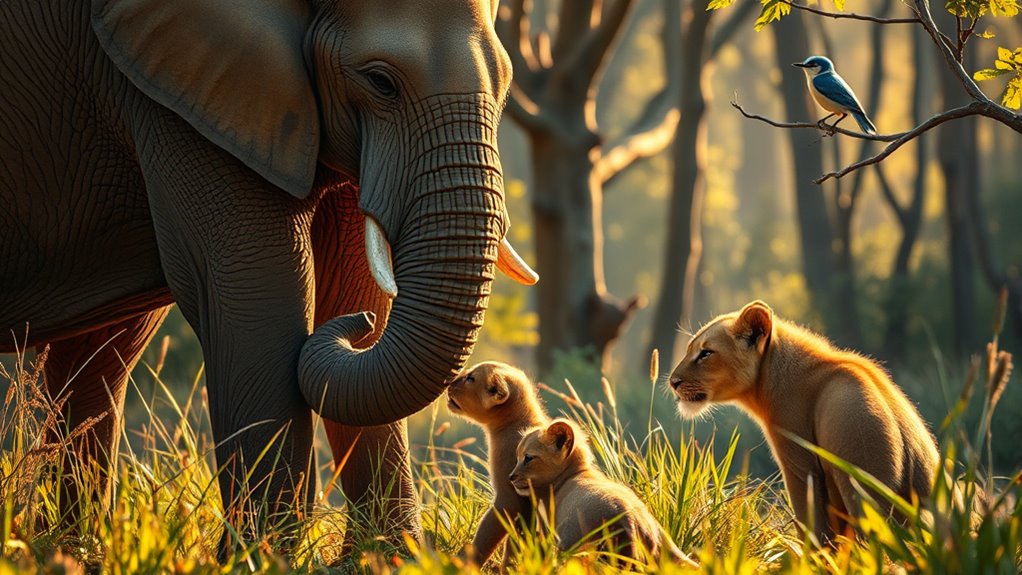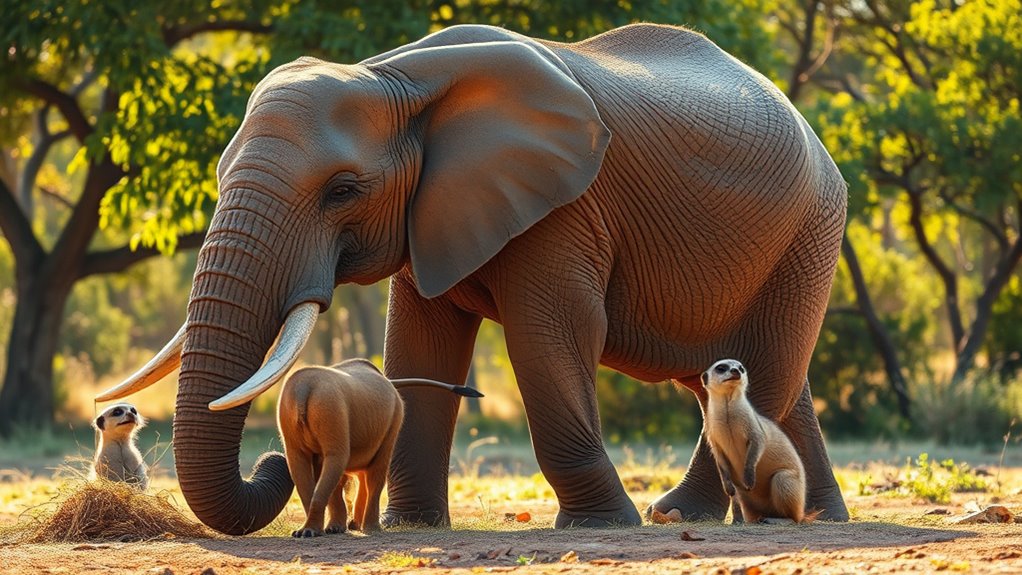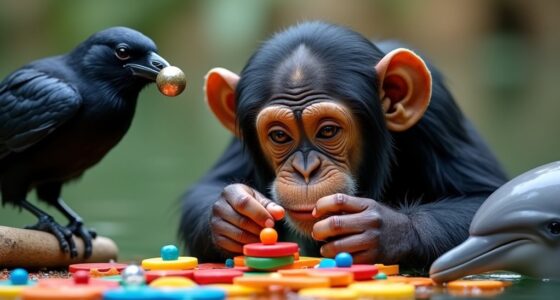Maternal care in the animal world varies greatly, showcasing unique strategies to boost offspring survival. Mammals often nurture their young in close-knit family units, like elephants, where empathy plays a crucial role. Birds actively feed and protect their chicks, while reptiles take a hands-off approach by laying eggs and leaving them to hatch independently. Even seahorses challenge traditional roles with males nurturing the young. There’s so much more to discover about these fascinating behaviors!
Key Takeaways
- Mammals, such as elephants, display strong animal bonding and maternal care, ensuring offspring survival through nurturing behaviors and social support.
- Elephants form tight-knit family groups led by a matriarch, showcasing empathy and collaboration during calving and protecting young.
- Reptiles, like turtles, utilize a hands-off approach by laying numerous eggs in sandy nests, prioritizing quantity over parental care.
- Birds actively nurture their young by building intricate nests and providing food, fostering strong parent-offspring bonds essential for survival.
- Seahorses exhibit unique parental roles, with males incubating eggs, challenging conventional maternal care notions and showcasing diverse reproductive strategies.

Have you ever wondered how different animals care for their young? The world of maternal care in animals is rich and varied, showcasing fascinating strategies that guarantee the survival of their offspring. From nurturing mammals to protective birds, each species has developed unique ways to bond with their young, driven by their reproductive strategies. Understanding these methods can give you insight into the complex relationships between mothers and their offspring.
Take, for instance, elephants. These gentle giants exhibit strong animal bonding behaviors. They form tight-knit family units, where the matriarch leads and cares for the young. Elephants demonstrate a remarkable level of empathy, often helping each other during calving and making sure the newborns stay safe. This close family structure not only promotes the survival of the calves but also strengthens social bonds within the herd.
Elephants showcase remarkable empathy and strong family bonds, ensuring the survival of their young through close-knit social structures.
In contrast, many reptiles utilize a different approach. A mother turtle lays hundreds of eggs in a sandy nest and then leaves them to fend for themselves, showcasing a more hands-off reproductive strategy. While it might seem harsh, this method allows turtles to produce many offspring, increasing the chances that some will survive to adulthood. The young turtles, once hatched, must instinctively find their way to the ocean, relying on their innate abilities rather than maternal care. This stark difference highlights how diverse animal bonding can be across species.
Birds, on the other hand, often demonstrate intense maternal care. Many species build intricate nests and actively feed their chicks, making sure they grow strong enough to leave the nest. For example, a mother robin will tirelessly catch worms and insects, bringing food back to her fledglings. This nurturing behavior fosters a strong bond, allowing the chicks to thrive under her protection, a crucial aspect of their reproductive strategy. Additionally, musical and movement activities can also play a role in the social development of young birds as they learn to communicate with their parents.
Another intriguing example is found in the sea, with certain fish species. Some, like the seahorse, exhibit a unique role reversal where the male carries and nurtures the young. The female deposits her eggs into the male’s pouch, and he protects and incubates them until they hatch. This striking example of animal bonding challenges traditional ideas about maternal care and demonstrates how reproductive strategies differ across species.
Ultimately, whether through nurturing care or strategic detachment, animal bonding plays a fundamental role in making certain the survival of young across the animal kingdom. By observing these remarkable behaviors, you can gain a deeper appreciation for the lengths to which animals go to make sure their offspring thrive.
Frequently Asked Questions
How Do Maternal Instincts Vary Across Different Animal Species?
Maternal instincts vary widely across species. You’ll notice that some animals, like elephants, form strong maternal bonding and nurture their young for years. In contrast, many fish exhibit species-specific behaviors, laying hundreds of eggs and showing little to no care afterward. Birds often feed and protect their chicks, but the level of care can differ markedly between species. Understanding these differences reveals the fascinating diversity of maternal instincts in the animal kingdom.
What Role Does Environment Play in Maternal Care Practices?
Oh sure, you think all mothers just wing it, right? Well, environmental influences shape maternal care in ways you’d never guess! In harsh habitats, mothers adapt their practices to ensure survival. For instance, in arid regions, they might nurse less frequently to conserve energy. Meanwhile, lush environments allow for more nurturing. So, next time you see a mother in the wild, remember—her habitat’s dictated her parenting style! Adjust or perish, right?
Do Male Animals Ever Participate in Maternal Care?
Yes, male animals can definitely participate in maternal care. In some species, like seahorses and certain bird species, males are actively involved in nurturing their young. They can help with tasks like incubating eggs or providing food, showcasing significant paternal involvement. This male nurturing not only supports the offspring’s survival but also strengthens the bond within the family unit. You might be surprised by how diverse these caregiving roles can be across the animal kingdom.
How Does Maternal Care Affect Offspring Survival Rates?
Maternal care critically boosts offspring survival rates by ensuring they receive proper nutrition and protection. When you invest time and resources into nurturing your young, you enhance their chances of thriving. This maternal investment helps them develop stronger immune systems and better foraging skills, enabling them to survive in the wild. Ultimately, a mother’s dedication directly correlates with the health and longevity of her offspring, making her role essential for their survival.
Can Maternal Care Behaviors Be Learned or Are They Instinctual?
Maternal care behaviors can be both learned and instinctual. You’ll find that genetic inheritance plays a significant role, with certain traits passed down, influencing how a mother interacts with her young. However, hormonal influence also shapes these behaviors, allowing mothers to adapt based on their environment. This combination of instinct and learning means that while some aspects of maternal care are innate, others can develop through experience and observation.
Conclusion
Just like a nurturing tree that shelters its young saplings from harsh winds, maternal care in the animal world is a demonstration of the bonds of love and protection. Every mother, from the fierce lioness to the gentle doe, weaves a tapestry of devotion and sacrifice, ensuring their offspring flourish. As you observe these fierce defenders and gentle nurturers, remember that their instinctual love mirrors the very essence of life itself, a dance as old as time, connecting us all.









